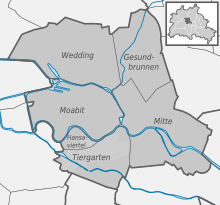Mitte
It borders on Charlottenburg-Wilmersdorf in the west, Reinickendorf in the north, Pankow in the east, Friedrichshain-Kreuzberg in the southeast, and Tempelhof-Schöneberg in the southwest.
A central square in Mitte is Alexanderplatz with the prominent Fernsehturm (TV tower), Germany's highest building, and the large railway station with connections to many subway (U-Bahn), tramway (Berlin trambahn), city trains (S-Bahn) and buses.
Juni to the Victory Column and the centre of former West Berlin in Charlottenburg, or Karl-Marx-Allee from Alexanderplatz to Friedrichshain and the eastern suburbs.
The former Mitte district had been established by the 1920 Greater Berlin Act and comprised large parts of the historic city around Alt-Berlin and Cölln.
There were some border control points, the most notable of which was Checkpoint Charlie between Kreuzberg and Mitte, which was operated by the United States Army and was open to foreigners and diplomats.
Most institutions of the German government have their seat at the Regierungsviertel The historic center is located in the locality of Mitte proper around the Berlin Palace.
Today it is enclosed by densely built-up areas by Hansaviertel and Moabit in the north, the Government District in the east and the City West and the Embassy Quarter in the southwest.
The Memorial to the Murdered Jews of Europe, the biggest victim group of the Nazi dictatorship, is located on the east side of the park, near the Brandenburg Gate and near the place where Hitler's New Reich Chancellery once was.


